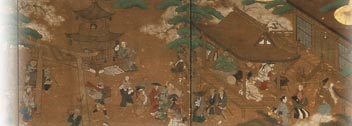International Conference: “Pourquoi le théâtre - sources et situation actuelle du théâtre”
Outline
| date | February 23 - 25, 2011 |
|---|---|
| Venue | France |
Details
For the past six years, the Tsubouchi Memorial Theatre Museum of Waseda University, in conjunction with the Université de Strasbourg and the Centre Européen d’Etudes Japonaises d’Alsace (CEEJA) in France, has participated in colloquia held in rotation every two years where the latest research results from both countries have been shared. In fiscal 2010, the three institutions held their third jointly organized colloquium in Strasbourg and Colmar, France. A total of five GCOE programme members and assistants from Waseda attended the workshop to give research presentations. These presenters and their papers were as follows: TAKEMOTO Mikio (GCOE programme leader and member), “Yuzaki and Kanze Troupes” (presented on February 23, 2011); HARADA Masumi (research assistant), “Popularity of the Ningyo Joruri Bunraku Drama of Taikoki-mono Genre and Konoshitakage Hazama Gassen” (24th); LI Wanju (research assistant), “The Process of Modernization and Appearance of the Commercial Theatre in Colonial Taiwan—A General View on Japanese and Taiwanese Theatre” (25th); KODAMA Ryuichi (progamme member), “Why ‘Pourquoi le Théâtre?’—Katarimono in Japanese Dramatic Performances” (25th); and FUJII Shintaro (progamme member), “Fantôme du théâtre, jeu de l'absent et de l'invisible” (“Phantoms of theatre, plays of the absent and the invisible”) (25th). In addition, Professor CHE Wenming, a collaborative researcher at Waseda from Shanxi Normal University in China and Director of the Shanxi Normal University Institute of Chinese Opera and Relics, was invited to give a presentation titled “Au sujet de la présence actuelle de theâtres antiques en Chine” (“Ancient theatre stages still surviving in present-day China”). Those interested in further details concerning this colloquium are encouraged to consult the Theatre and Film Studies 2010 report to be published at the end of this fiscal year, as well as the collection of papers planned for publication by CEEJA, as noted below.In addition to presenters from Waseda and the Université de Strasbourg, this international colloquium was attended by lecturers from other universities in France, as well as from Germany, Spain, and other European countries. It was a major conference, with a total of 21 researchers giving presentations over the course of three days. Content was varied, ranging from the theatrical theories of ancient Greece to modern theatre in Japan. As can be seen from the presentation descriptions above, participants from Waseda unintentionally gave in their combined presentations a historical overview of Japanese theatre. All of their talks were followed by lively question-and-answer sessions that sometimes touched on the very basic question, “What is theatre?” Presentations on Japanese theatre were not restricted to Japanese researchers, however. A French researcher, for example, gave a paper on Zeami’s Noh theory, while two German researchers also gave papers on Japanese themes: one on Kurokawa Noh, and the other on Japanese theatre in the 1960s. In this sense the colloquium symbolized the international breadth of Japanese theatre studies.
The papers presented at this colloquium will be collected and published (in French and English) by CEEJA. The collection will take its place beside other Waseda efforts to disseminate important research results abroad, including Kaette kita bunraku firumu “Nihon no ningyo geki—ningyo joruri” kenkyu hokoku (The return of the Bunraku film Marionnettes japonaises), which was published with the cooperation of the Musée Albert Kahn; and the special report from the 2009 international symposium held in Paris involving the entire Theatre Museum GCOE Programme titled “Theatre, Dance and the Arts Scene: Exchanges between Japan and France in the 20th Century,” which was published in the French theatre journal Théâtre/Public in February 2010.
The administrative duties accompanying this colloquium were mind-boggling, and we would like to extend our sincerest thanks to Professor Sakae Murakami-Giroux of Université de Strasbourg, who handled all the details with such aplomb while greeting us with a warm smile, and to the CEEJA staff.


